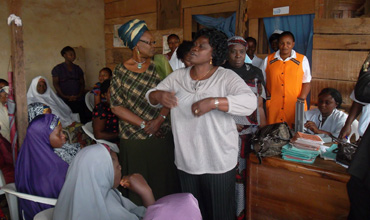Review of Prevention of Mother-To-Child Transmission (PMTCT) program in a Primary Healthcare Centre in Abuja, Nigeria

Abstract:
Background: It
has been shown that nearly all pediatric seropositive HIV cases were infected
via their seropositive mothers, as well; almost all of these cases can be
prevented through a robust PMTCT service that provides extremely effective
Anti-retroviral therapy and prophylactic intervention (FMOH, 2010).
As we work towards elimination of MTCT of HIV in our
country, the importance of this review of PMTCT services cannot be over
emphasized.
Objectives: The
objectives of the study were; to assess the prevalence of HIV among pregnant
women who attended ANC at the Health center (January –December, 2015). 2. To
evaluate the percentage of HIV positive pregnant women who were placed on ART
in the review period. 3. To ascertain the percentage of babies born to HIV
positive mothers who were given ART in the review period.
Methods: Secondary
data review was employed in this descriptive cross-sectional study. It involved
data extraction from ANC booking registers, PMTCT HIV screening registers, ART
administration registers and case/delivery notes of HIV positive mothers,
covering the review period of January-December 2015, in the study center.
Results: All
the 1,418 ANC clients reviewed were screened for HIV with a sero-prevalence of
2.8%. However, the percentage of seropositive clients who were placed on ART
was 75%, while, 25% were lost to follow-up. Furthermore, only 33% of the babies
born to seropositive mothers received ART prophylaxis in this center.
Conclusion:
An ANC sero-prevalence of 2.8% with below average ART initiation for positive
pregnant women and babies born to them portends great danger towards
elimination of MTCT of HIV. Therefore the study recommends urgent strengthening
of PMTCT in this center and other similar centers across the country.
Keywords: PMTCT, Ante-Natal
Care, HIV, Prevalence, Anti-Retroviral Therapy, Primary Health Centre
References:
[1] AIDSINFO (2016). Education
materials: HIV-1. Accessed from:
https://aidsinfo.nih.gov/education-materials/glossary/314/hiv-1
[2] FMOH of Nigeria, (2010). National Guideline
for Prevention of Mother to Child Transmission (PMTCT) of HIV/AIDS. Pp 1
[3] FMOH, of Nigeria, HSS (2014). 2014 National HIV Sero-prevalence
Sentinel Survey among Pregnant Women Attending Antenatal Clinics in Nigeria. pp
2.
[4] Ghana AIDS commission GAC (2013). Summary of the 2013 HIV sentinel survey report.
Accessed from: http://ghanaids.gov.gh/gac1/aids_info.php
[5] IATT, (2015). Inter-agency Task Team on
the Prevention and Treatment of HIV Infection in Pregnant Women, Mothers and Children.
Monitoring & Evaluation Framework for Antiretroviral Treatment for Pregnant
and Breastfeeding Women Living with HIV and Their Infants. (IATT M&E Option
B+ Framework). CDC, WHO and UNICEF. New York. Accessed from: http://www.emtct-iatt.org/wp-content/uploads/2015/05/IATT-Framework-May-2015.pdf
[6] Kenya AIDS Response Progress Report (2014).
Progress towards zero. Accessed from http://www.unaids.org/sites/default/files/country/documents/KEN_narrative_report_2014.pdf
[7] Kiptoo M., Mpoke S., Ng'ang'a Z., Mueke
J., Okoth F., Songok E. (2009). Survey on prevalence and risk factors on HIV-1 among
pregnant women in North-Rift, Kenya: a hospital based cross-sectional study conducted
between 2005 and 2006, 9:
pp10. doi: 10.1186/1472-698X-9-10.
[8] National Agency for the Control of AIDS
(NACA) (2014). Federal republic of Nigeria Global AIDS Response. Country Progress
Report, Nigeria GARPR 2014. p.13 Accessed from: http://www.unaids.org/sites/default/files/country/documents/NGA_narrative_report_2014.pdf
[9] Okerentugba P.O., Uchendu S.C., Okonko
I.O. (2015). Prevalence of HIV among Pregnant
Women in Rumubiakani, Port Harcourt. Nigeria. Public Health Research. 5(2): 58-65.doi:10.5923/j.phr.20150502.03
[10] Sagay A.S., Kapiga S.H., Imade G.E., Sankale
J.L., Idoko J., Kanki P. (2005). HIV Infection among pregnant women in Nigeria. International journal of Gynecology and Obstetrics, 90: (1). Pp 61-67. Doi 10.1016/j.jigo.2005.30.030
[11] Thailand National AIDS Committee (NAC).
(2015). Thailand AIDS response progress report, 2015. Accessed from http://www.unaids.org/sites/default/files/country/documents/THA_narrative_report_2015.pdf
[12] United Nations. (2015). Sustainable Development
Goals (SDGs). Accessed from: http://www.un.org/sustainabledevelopment/sustainable-development-goals/
[13] WHO1 (2016). HIV/AIDS, online Q & A. (updated
July, 2016). Accessed from: http://www.who.int/features/qa/71/en/
[14] WHO2 (2016). HIV/AIDS, Mother-to-child transmission
of HIV (updated June, 2016). Accessed from: http://www.who.int/hiv/topics/mtct/en/
[15] WHO3 (2016). Thailand is first country in Asia to
eliminate mother-to-child transmission of HIV and syphilis. Accessed from: http://www.searo.who.int/mediacentre/releases/2016/1627/en/index.html
[16] WHO4 (2016). WHO validates elimination of mother-to-child transmission of HIV and syphilis in Armenia, Belarus and the Republic of Moldova. (Updated June, 2016). Accessed from: http://www.euro.who.int/en/media-centre/sections/press-releases/2016/06/who-validates-elimination-of-mother-to-child-transmission-of-hiv-and-syphilis-in-armenia,-belarus-and-the-republic-of-moldova.
[17] WHO5 (2016). Consolidated guidelines on the use of antiretroviral drugs for treating and preventing HIV infection. Summary of Recommendations. Accessed from: http://www.who.int/hiv/pub/arv/summary-recommendations.pdf

